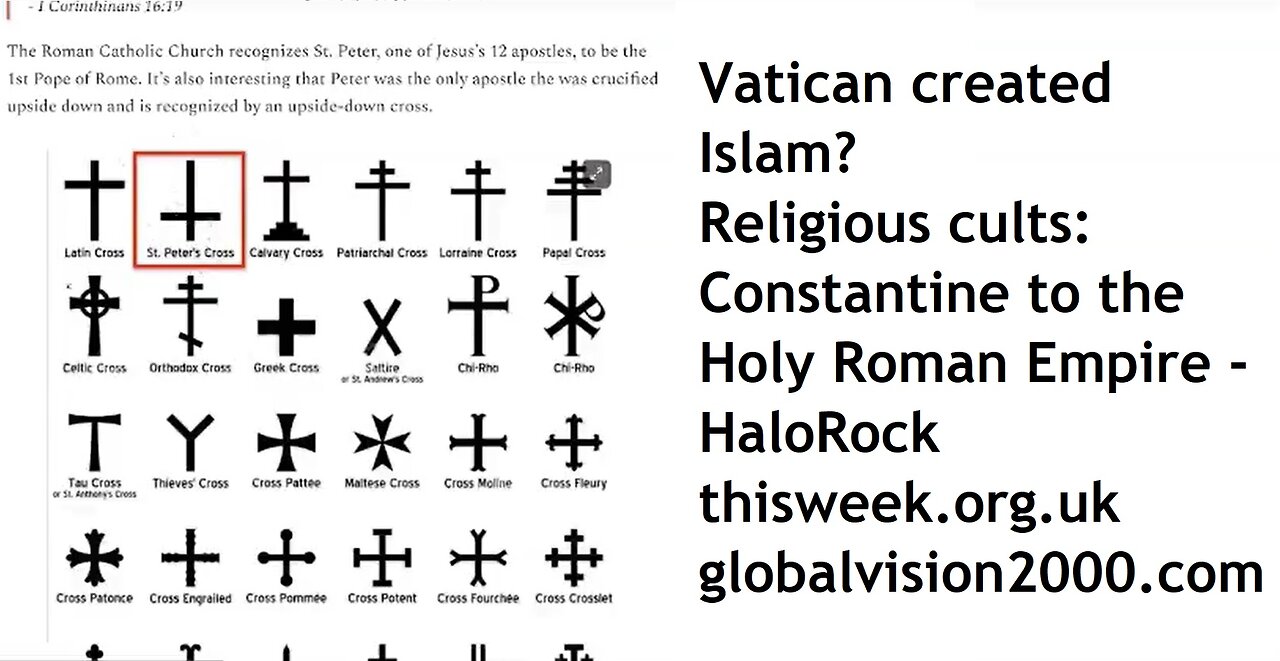Premium Only Content

Did the Vatican create Islam? Religious mystery cults: Constantine to Holy Roman Empire w/ HaloRock
HaloRock - Constantine Vatican to the The Holy Roman Empire (documentary)
What is a Mystery Religion?
Information is scarce concerning the ancient Mystery Religion cults in which many Greco-Romans found spiritual belonging and redemption from as far back as the 6th century BCE until the introduction of Christianity into the empire. At this period of time, cults had no evil or manipulative connotations, as they do today. These cults allowed early Greeks and Romans to worship their gods brought in from the regions of Greece, Rome, Persia, Africa and all other regions of Roman conquest. The strains of information on the Mystery Religions are fiercely debated and interpreted precisely because the cults were so mysterious, with initiates sworn to secrecy. What is left for historians and scholars of religion to study is only decaying temples and snippets left by philosophers and writers, here and there, on what they saw, heard, or were allowed to write concerning the cults of the Mystery Religions. Most sources on the subject are biased. Philosophers denounced superstition and Christians found demons in all aspects of the Mystery Religions, and the destruction of images and shrines (iconoclasm) compromised Mystery Religion evidence and information.[Endnote i] The Mystery Religions are also difficult to understand because the initiation ceremonies of the cults were so secretive, and very few initiates broke their vow to write about their experience.[ii] Though there is no evidence to suggest any bridges between the Mystery Religions and Christianity, and there is no way to know if anything was copied between the Mystery Religions and Christianity, there is no denying that there are striking similarities and correlations between Christianity and the Mystery Religions. Both were able to attract religious followers because of the promised chance of personal salvation and a comforting sense of belonging in a small community of like-minded comrades. As Christianity spread throughout the Roman Empire, many cult members joined the Christian Church, for the Mystery Religion members were the exact type of people who wanted a more personal relationship with their deity.
To understand the ancient Mystery Religions, one must understand the idea of early cults. All a cult requires is a location of worship, a ritual to be performed, and deity to be the patron of the gathering. The Mystery Religions acquired their ‘mystery’ name because of the secretive initiation that one was required to undertake if he or she wished to join the cult of a god of the Roman Empire. In Religions of the Hellenistic-Roman Age, Antonía Tripolitis says the ritual of the initiation allowed the initiates to come face-to-face with the patron gods of the cult.[iii] Though the Mystery Religions were popular and had members in many regions, the cults themselves had very little organization beyond initiation and ranks of devotion. There was no “established clerical hierarchy or a professional clergy, nor a developed organizational structure.”[iv] Mystery Religions share common themes: ritual cleansing, or other preparations for initiation day, a personal relationship with the deity after initiation and the members of the cults believe themselves to be able to receive salvation through the cult, or at least a better afterlife.[v]
The Mysteries of Rome
The cults of the Roman Empire originated outside of Italy. In times of need, the Imperial capital, Rome, would invite the cults of foreign deities. In “The Eucharist and the Mystery Religions,” John McConnell writes, “The principle Mysteries were the Eleusinian (Demeter, Persephone, Dionysus), the Thracian (Dionysus-Zagreus), the Anatolian (Attis and Cybele), the Egyptian (Isis and Osiris-Serapis), and the Persian (Mithra).”[vi] The willingness of the Romans to welcome outside gods came from their loss of faith in their original gods. As the story goes, the Romans abandoned their native animism to devote themselves to the Greek-based Capitoline gods (Jupiter, Juno and Minerva) around 509 BCE.[vii] This set a precedent that the Romans could overcome hardships by inviting foreign gods and adopting them as their own...
https://thehistorianshut.com/2016/11/17/the-ancient-mystery-religion-cults-of-rome-part-one/
thisweek.org.uk
globalvision2000.com
-
 LIVE
LIVE
The Bubba Army
2 days agoBad Bunny Disrespectful? - Bubba the Love Sponge® Show | 10/06/25
1,805 watching -
 2:00:52
2:00:52
BEK TV
3 days agoTrent Loos in the Morning - 10/06/2025
6.67K -
 1:21:55
1:21:55
Mike Rowe
4 days agoThis Is How We CHANGE Education Today | Meredith Olson #451 | The Way I Heard It
12.2K12 -
 1:18:46
1:18:46
Steve-O's Wild Ride! Podcast
3 days ago $1.29 earnedJacoby Shaddix Breaks Down Papa Roach Longevity | Wild Ride #269
10K4 -
 17:42
17:42
Nate The Lawyer
2 days ago $3.13 earnedHow A Criminal Illegal Alien Scammed His Way Into A $300k Government Job.
12.6K14 -
 28:46
28:46
DeVory Darkins
15 hours ago $14.75 earnedPritzker HUMILIATED after brutal fact check as Democrat candidate calls for political assassination
24.4K99 -
 19:54
19:54
Forrest Galante
12 hours agoPrivate Tour Of America's Best Marine Animal Facility
37.7K7 -
 9:25
9:25
MattMorseTV
1 day ago $18.58 earnedSupreme Court just DROPPED a NUKE.
32.3K72 -
 13:25
13:25
Nikko Ortiz
1 day agoWorst Karen TikTok Fails
32.9K11 -
 40:24
40:24
The Connect: With Johnny Mitchell
2 days ago $22.21 earnedInside The WORST Drug-Infested Slums Of Medellin, Colombia
72.9K31
